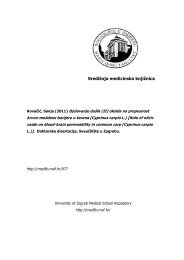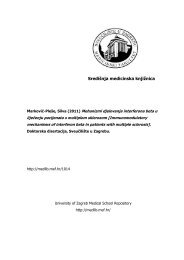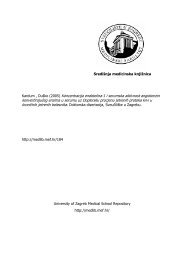Klinefelter Syndrome and Acute Basophilic Leukaemia
Klinefelter Syndrome and Acute Basophilic Leukaemia
Klinefelter Syndrome and Acute Basophilic Leukaemia
Create successful ePaper yourself
Turn your PDF publications into a flip-book with our unique Google optimized e-Paper software.
Coll. Antropol. 34 (2010) 2: 657–660Case report<strong>Klinefelter</strong> <strong>Syndrome</strong> <strong>and</strong> <strong>Acute</strong> <strong>Basophilic</strong><strong>Leukaemia</strong> – Case ReportNives Ljubi} 1 , Nada Lang 2,6 , Ika Kardum Skelin 3,6 , Ru`ica Lasan 4 , Mara Dominis 5,6 , Leila Perkovi} 1 ,Dubraka @upani}-Krmek 2 <strong>and</strong> Anita Grgurevi}-Batinica 11 Department of Pathology <strong>and</strong> Cytology, »Sveti Duh« General Hospital, Zagreb, Croatia2 Department of Internal Medicine, »Sveti Duh« General Hospital, Zagreb, Croatia3 Division of Cytology, »Merkur« University Hospital, Zagreb, Croatia4 Department of Cytogenetic, Zagreb University Hospital Center, Zagreb, Croatia5 Department of Pathology <strong>and</strong> Cytology, »Merkur« University Hospital, Zagreb, Croatia6 Zagreb University, School of Medicine, Zagreb, CroatiaABSTRACTPatients with 47, XXY karyotype (<strong>Klinefelter</strong> syndrome) appear to have increased risk of developing cancer, especiallymale breast cancer, germ cell tumours <strong>and</strong> non Hodgkin lymphomas, but rarely acute myeloid leukaemia. We report a patientwith acute basophilic leukaemia with 47, XXY karyotype in both the tumour <strong>and</strong> constitutional cells. <strong>Acute</strong> basophilicleukaemia is very rare disease comprising less than 1% of all acute myieloid leukaemias. Morphological characteristicof leukaemic blast cells is moderately basophilic cytoplasm containing a variable number of coarse basophilicgranules. The most characteristic cytochemical reaction is metachromatic positivity with toluidine blue. Blast are myeloperoxidasenegative. Also leukemic blasts express myeloid <strong>and</strong> monocyte markers. There is no consistent chromosomalabnormality identified in this leukaemia. This is the first reported case of acute basophilic leukaemia in patient with<strong>Klinefelter</strong> syndrome. In this article the medical history of the patient is given <strong>and</strong> the possible connection betweenKlinefeter syndrome <strong>and</strong> acute myeloid leukaemia is discussed.Key words: <strong>Klinefelter</strong> syndrome, acute myeloid leukaemia, acute basophilic leukaemiaIntroduction<strong>Acute</strong> basophilic leukaemia is an acute myeloid leukaemia(AML) in which the primary differentiation is tobasophils. As in other acute leukaemia, patients presentfeatures related to bone marrow failure. Cutaneous involvement,organomegaly, lytic lesions <strong>and</strong> symptoms relatedto hyperhistaminemia may be present 1 . Morphologicalcharacteristic of leukaemic blast cells is moderatelybasophilic cytoplasm containing a variable number ofcoarse basophilic granules. The most characteristic cytochemicalreaction is metachromatic positivity with toluidineblue. Blast are negative for myeloperoxidase bycytochemistry. Leukaemic blast cells express myeloidmarkers CD13 <strong>and</strong> CD33 <strong>and</strong> are usually positive forCD123, CD203c <strong>and</strong> CD11b. In contrast to normal basophilsmay be positive for HLA-DR, but are negative forCD117 2 . It has been generally associated with poor prognosis.<strong>Klinefelter</strong> syndrome is the most common cause formale hypogonadism 3 . It is characterised with underdevelopedtestis, gynaecomastia, eunuchoidism, aspermia<strong>and</strong> an increased level of serum gonadotropin 4 . The essentialcharacteristic is an abnormal karyotype with oneor more extra X. There have been several reports of patientswith <strong>Klinefelter</strong> syndrome who developed varioustypes of tumours, especially breast cancer, germ cell tumours<strong>and</strong> lymphomas. Thus the relationship betweenthis constitutional chromosome alteration <strong>and</strong> incidenceReceived for publication September 9, 2009657
N. Ljubi} et al.: <strong>Klinefelter</strong> <strong>Syndrome</strong> <strong>and</strong> <strong>Acute</strong> <strong>Basophilic</strong> <strong>Leukaemia</strong>, Coll. Antropol. 34 (2010) 2: 657–660of leukaemia seems questionable <strong>and</strong> also its relationshipto tumorogenesis. Herein, we review a case of <strong>Klinefelter</strong>syndrome along with acute myeloid leukaemia(AML).Case ReportThe 63-year old male with history of <strong>Klinefelter</strong> syndromewas admitted to our hospital with high fever <strong>and</strong>cough. In the patient medical history he had never hadprevious haematological disease. Physical examinationdemonstrated reduced sounds on the right chest <strong>and</strong> fewecchymoses. Laboratory investigation revealed leucopoenia(white blood cell count of 2.16x10 9 /L), anaemia (redblood cells count of 2.12x10 12 /L <strong>and</strong> hemoglobin 76 g/L)<strong>and</strong> thrombocytopenia (platelet count of 8x10 9 /L). Bloodchemistry showed elevated level of aspartat transferase(42 U/L) <strong>and</strong> lactate dehydrogenase (883 U/L). C-reativeprotein was also elevated (45 g/L). Ultrasound of the abdomenshowed hepatomegaly. In peripheral blood smearwere found 10% myeloblasts, 4% b<strong>and</strong>s, 51% neutrophilicgranulocytes, 2% eosinophils, 2% basophils <strong>and</strong>37% lymphocytes. Bone marrow aspirate demonstratedhypocellular smear with reduced erythrocytopoiesis, reduced,morphologically regular thrombocytopoiesis <strong>and</strong>33% leukemic blast cells proving morphologically acutemyeloid leukaemia (Figure 1). Blast cells were of mediumsize with a high nuclear-cytoplasmic ratio, a nucleus withdispersed chromatin <strong>and</strong> one or three prominent nucleoli.The cytoplasm was moderately basophilic <strong>and</strong> containeda variable number of coarse basophilic granules.Also we found 14% basophilic cells. Toluidin blue cythocemicalstaining showed positivity of 17% of cells(Figure 2) <strong>and</strong> leukemic blast cells were myeloperoxydase(Figure 3) <strong>and</strong> Sudan black negative, so the diagnosisof acute basophilic leukaemia was set. Histologicalexamination of the bone marrow confirmed AML. Flowcytometric analysis of blast cells showed CD45, CD13,CD33 <strong>and</strong> HLA D/DR positive expression. Chromosomeanalysis of bone marrow cells revealed the same karyotype,47 XXY (Figure 4), like in peripheral karyotypeblood. FISH analyses for probes 6q21, 8q24, 7q22 <strong>and</strong>7q35 showed no clonal aberration <strong>and</strong> FISH analysis forBCR/ABL fusion gene was not done. Patient was treatedwith cytarabin <strong>and</strong> daunorubicin (7+3) with partial response.Three months following the diagnosis, the patientdied due to sepsis with multiorganic failure.Fig. 3. Myeloperoxydase negative staining of leukemic blastcells in bone marrow aspirate (x1000).Fig. 1. Smear of bone marrow aspiration of acute basophilicleukemia, Pappenheim x1000.Fig. 2. Toluidin blue positive staining of leukemic blast cellsin bone marrow aspirate (x1000).Fig. 4. Chromosome analysis of bone marrow cells shows 47,XXY karyotype658
N. Ljubi} et al.: <strong>Klinefelter</strong> <strong>Syndrome</strong> <strong>and</strong> <strong>Acute</strong> <strong>Basophilic</strong> <strong>Leukaemia</strong>, Coll. Antropol. 34 (2010) 2: 657–660Discussion<strong>Klinefelter</strong> syndrome is the most common sex chromosomedisorder <strong>and</strong> affects 1 in 500 men. It was first reportedin 1942, describing a syndrome characterised bygynaecomastia, aspermiogenesis without a Leydigism <strong>and</strong>increase excretion of follicle stimulation hormone 4 .In1959 it was discovered that these abnormalities are derivedfrom the chromosome alteration, 47 XXY 5 . Patientsmay lack some clinical features, but small testicles <strong>and</strong>azoospermia are constant. Serum testosterone <strong>and</strong> dihydrotestosteronelevels are low <strong>and</strong> serum gonadotropinsare uniformly increased.Many case reports have suggested an association between<strong>Klinefelter</strong> syndrome <strong>and</strong> various cancers. Thereforemuch attention has been paid to the relation betweenchromosomal alteration <strong>and</strong> oncogenesis. The increasedrisk in several types of cancers suggests that theextra X chromosome may be involved in tumorogenesisassociated with this syndrome. The date demonstratedthat loss-of-inactive X in the female derived cancer cellsis mainly achieved by loss of an inactive X chromosome,followed by multiplication of an identical active X chromosome6 .Also it was published that XXY cell line from patientswith lung cancer manifested a 3-fold increase in susceptibilityto SV 40 transformation compared to the normalcell line of the same patient <strong>and</strong> in individuals with normalkaryotype <strong>and</strong> no history of cancer. Such an abnormalsusceptibility to SV 40 infection in vitro has beensuggested as an indicator of individuals with predispositionto cancer 7 . Simian virus (SV40) is DNA tumor virus.Different domains of large T protein encoded by SV 40bind to p53 <strong>and</strong> Rb inhibiting their function which inducecell transformation in cell cultures. Cell culturesfrom patients with diseases that is associated with incidenceof chromosomal aberrations <strong>and</strong> the greatly increasedrisk of neoplasia showed a much greater susceptibilityto transformation in culture by SV 40 whencompared from normal individuals <strong>and</strong> from the individualswith disease not associated with an increased tumorincidence.Increased incidence of malignant disorders of patientswith <strong>Klinefelter</strong> syndrome is still investigated. Besidessome case reports being published, there are only few cohortstudies investigating this problem. Danish cohortstudy in 1992 8 , British cohort study in 2001 9 <strong>and</strong> in 2005study of UK Clinical Cytologic Group 10 . They all agreethat although findings in these studies were not mutuallyconsistent there is evidence that men with <strong>Klinefelter</strong>syndrome have increased risk of breast cancer,midline teratoma <strong>and</strong> there seems a supported suggestionof increased risk of several other malignancies comparedwith men in general population. In 1961 Mammuneswas the first who describe a case of acutemyeloid leukaemia in patient with <strong>Klinefelter</strong> syndrome11 . Although several case reports were published, cohortstudies showed that AML in <strong>Klinefelter</strong> syndromewas a by-chance association.Concerning acute basophilic leukaemia this is thefirst described case in patient with <strong>Klinefelter</strong> syndrome.<strong>Acute</strong> basophilic leukaemia is very rare disease comprisingless than 1% of all acute myeloid leukaemias. There isno consistent chromosomal abnormality identified in thesecases 1 . Although some authors described increase in prevalenceof AML, they assume that these findings are intriguing,because it is at least partly due to the increasedfrequency of cytogenetic studies in the patients withhaematological malignancies 12 . So we assume that largerstudies are required to either confirm or disapprove theassociation of <strong>Klinefelter</strong> syndrome <strong>and</strong> acute myeloidleukaemia.REFERENCES1. SWERDLOW SH,CAMPO E, HARRIS NL, JAFFE ES, PILERI SA,STEIN H, THIELE J, VARDIMAN JW, WHO classification of tumors ofhaematopoietic <strong>and</strong> lymphoid tissues (IARC, Lyon, 2008). — 2. LICHT-MAN MA, SEGEL GB, Blood Cells Mol Dis, 35 (2005) 370. — 3. MUTS--HOMSMA SMJ, MULLER HP, GERAEDTS JPM, Blut, 44 (1981) 15. —4. KLINEFELTER HF JR, REINFESTEIN EC JR, ALBRIGHT F, J ClinEndocrinol, 2 (1942) 615. — 5. JAKOB PA, STRONG JA, Nature, 183(1959) 302. — 6. KAWAKAMI T, ZHANG C, TANIGUCHI T, KIM CJ,OKADA Y, SUGIHARA H, HATTORI T, REEVE AE, OGAWA O,OKOMOTO K, Oncogene, 23 (2004) 6163. — 7. MUKERJEE D, BOWENJ, ANDERSON DE, Cancer Res, 30 (1970) 1769. — 8. HASLE H, MEL-LEMGAARD A, NIELSEN J, HANSEN J, Cancer, 71 (1995) 876. — 9.SWERDLOW AJ, HERMON C, JACOBS PA, ALBERMAN E, BERAL V,DAKER M, Ann Hum Genet, 65 (2001) 177. — 10. SWERDLOW AJ,SCHOEMAKER MJ, HIGGINS CD, WRIGHT AF, JACOBS PA, J NatlCancer Inst, 97 (2005) 1204. — 11. MAMMUNES P, Lancet, 2 (1961) 26.— 12. KEUNG YK, BUSS D, CHAUVENET A, PETTENATI M, CancerGenet <strong>and</strong> Cytogenet, 139 (2002) 9.N. Ljubi}Department of Pathology <strong>and</strong> Cytology, »Sveti Duh« General Hospital, Sveti Duh 64, 10000 Zagreb, Croatiae-mail: niveslj@gmail.com659
N. Ljubi} et al.: <strong>Klinefelter</strong> <strong>Syndrome</strong> <strong>and</strong> <strong>Acute</strong> <strong>Basophilic</strong> <strong>Leukaemia</strong>, Coll. Antropol. 34 (2010) 2: 657–660PRIKAZ SLU^AJA KLINEFELTEROVA SINDROMA I AKTUNE BAZOFILNE LEUKEMIJESA@ETAKBolesnici s 47, XXY kariotipom (<strong>Klinefelter</strong>ovim sindromom) pokazuju ve}i rizik razvoja karcinoma dojke, karcinomazametnih stanica i non- Hodgkin limfoma, ali rijetko dolazi do razvoja akutne mijeloi~ne leukemije. Prikazali smobolesnika s akutnom bazofilnom leukemijom, s ranije dijagnosticiranim <strong>Klinefelter</strong>ovim sindromom, kod kojeg se i utumorskim stanicama nalazi 47, XXY kariotip. Akutna bazofilna leukemija je veoma rijetka bolest, koja sa~injava manjeod 1% svih akutnih mijeloi~nih leukemija. Kod nje se u ko{tanoj sr`i nalaze nezrele bazofilne stanice, gdje se u citoplazminalaze bazofilne granule. Blasti su izrazito pozitivni na toluidin dok su mijeloperoksidaza negativni. PAS reakcija iklor-acetat-esteraza u bazofilnim blastima su ~esto pozitivni. Imunolo{ki blasti nose mijeloidne i monocitne biljege.Kod ovog oblika leukemije nije dokazana povezanost sa specifi~nim kromosomskim poreme}ajima. Ovo je prvi prikazanislu~aj akutne bazofilne leukemije kod bolesnika s <strong>Klinefelter</strong>ovim sindromom. U ovom radu smo iznijeli medicinskupovijest bolesti bolesnika, a tako|er smo razmotrili mogu}u vezu <strong>Klinefelter</strong>ovog sindroma i akutne mijeloi~neleukemije.660
















